Visiting Iiyama’s Traditional fall festival
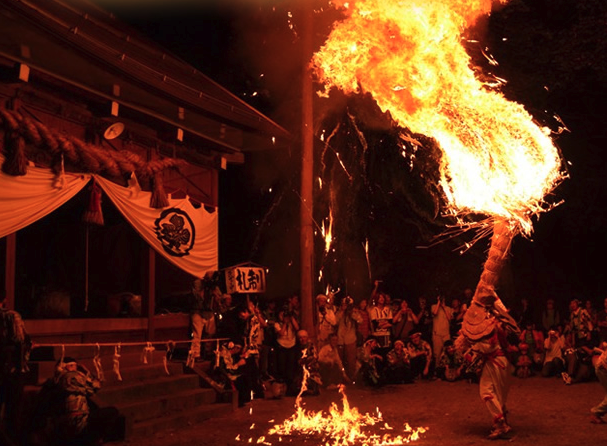
Each fall, festivals are held in each of Iiyama City’s districts to pray for an abundant harvest and the continued well-being of local families. Local people perform various traditional dances, including a lion dance, long-sword dance, and a hopping dance as offerings. These festivals are popular among Iiyama residents, and some even attract tourists, making Iiyama crowded and bustling during this time of year. These festivals are often the biggest of the year for each district, and they are a great opportunity to experience Iiyama’s authentic traditions and culture. For the most part, the festivals are not flashy, but they show the pride of local people who have carefully preserved local culture. Autumn festivals are held every weekend in September, so why not see one for yourself!? Check out reports from these four Iiyama fall festivals: Nadachi Shrine Annual Festival, Narazawa Daitengu Festival, Shizuma Shrine Annual Festival, and Gosoku-daidaikagura Festival.
Nadachi Shrine Annual Festival(Kuwanagawa district)
Celebrated in Iiyama since the Edo period, the festival at Nadachi Shrine in Kuwanagawa district has been designated one of the city’s important cultural properties. From the city center, it takes about 20 minutes by car to reach Kuwanagawa, the snowiest area in Iiyama. The Nadachi Shrine festival begins at 9 PM, and men and women of all ages mingle on the temple grounds. As locals call out to each other in greeting, even a visitor can sense the important role this festival plays in Iiyama culture.
In a plaza just before the shrine gates, a young man equipped with flute and drums has already performed the lion journey dance. Men in crested kimono hold paper lanterns, standing in dignified lines to both sides of the gates, and creating an air of holiness. In front of the gates, preparations for the torch begin as a man puts on the mask of a long-nosed goblin. With a sword strapped to his side, the man stands without moving an inch. A rope stretches between the shrine gates, blocking the way. With the torch lit, and held up high by a guide, the dance of the long-nosed goblin begins, with the goblin dancer thrusting his sword toward the light. Watching with rapt attention as the movements of the dance are repeated, it feels like a solemn exchange of greetings with God. Two guides hold torches, one dressed quite youthfully. It’s great that young people participate in the festival, continuing to preserve ancient Iiyama traditions!
Led by the guides, the long-nosed goblin gradually comes closer to the ceremonial Shinto rope. Attempting to cut the rope with his sword, the goblin backs up several times to shouts of “Not yet!” from the crowd. After several failed attempts, the goblin finally manages to cut the rope, prompting applause from the onlookers and the approach of the boys performing the lion and long-sword dances. In previous eras, a rope was also hung between the gates of the inner shrine, and a similar long-nosed goblin dance was performed. The dance involved holding a hand up to the heavens (with forefinger and middle finger pointed upwards), approaching the torch, and then escaping from it; this was thought to purify the grounds. At today’s ceremony, after the rope is cut, people stream into the main shrine.


In the front shrine, a parish representative, the District Chief of Kuwanagawa, and the head priest sit to the side of the stage. With the men variously garbed in crested kimono and hakama (a formal skirt worn by men) and suits, the setup seems to indicate the start of solemn sacred rites. First, the Japanese halberd and Mio dances are performed. During the halberd dance, two elementary school-aged children wield (replica) long swords, performing a dance with complex patterns of weaving and turning, doubtless the product of long hours of practice. In comparison, the Mio dance is slow and peaceful, with two young girls pantomiming the cleansing of the front shrine. Just beside Nadachi Shrine is Okayama Elementary School, which has only a few dozen students. It was deeply impressive that the traditions of the Japanese halberd dance and Mio dance were kept alive by just a few children. During the festival flute and taiko drum players are given sacred sake, and rhythmic shouts ring out through the dusk. It’s clear that everyone is enjoying the one-night festival, and even small children are allowed to stay up late for the special occation.
Next is the sword dance, performed by three middle school boys and said to be particularly rare. It is sometimes rumored that the dance came from ancient Echigo prefecture, or else that it was handed down as a local tradition. A performance of great strength and intensity, this dance too requires a great deal of practice. In the lion dance, the two performers desperately pursue a golden ball. It’s likely that there is a traditional story behind this performance, although it is not commonly known. Still, just watching the scene is interesting. Finally, three clowns in masks (hyottoko-no-men) perform an act called Saitoromen. This dance comes from a festival of feudal lord Saisashitori, and reenacts the catching of small birds as feed for the lord’s falcons. In the version performed at Nadachi shrine, the dance is very comical. As the performance continues, the crowd laughs at the slapstick drama of men with clownish masks, many with indecent expressions, running after small birds. The dance often includes a great deal of ad-libbed movement, which depends on expressive abilities of the dancer. From the reaction of the crowd, I got the sense that this year’s performance was particularly funny. At last a small bird is captured, and the festival ends. The series of dances felt like watching a long drama, conforming to ancient traditions, and next thing I knew it was half past one in the morning. It is a quintissential autumn festival, designed to give thanks and prayer for God and nature, and allow locals to gather and enjoy themselves.
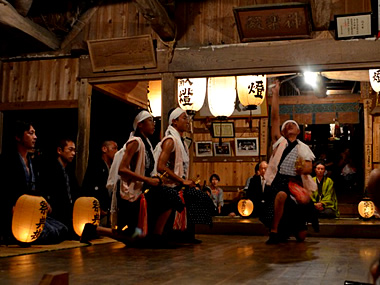
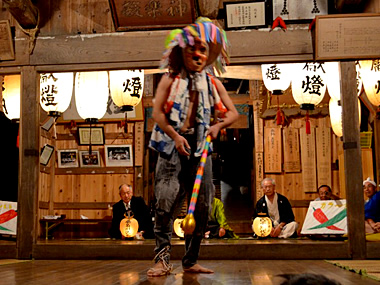
Location: Nadachi Shrine – Iiyama City, Ooaza Teruoka 495
Date: The Saturday and Sunday closest to August 31st
Inquiry: Shinshu-Iiyama Tourism Bureau
TEL: 0269-62-3133
Shizuma Shrine annual festival(Akitsu District)
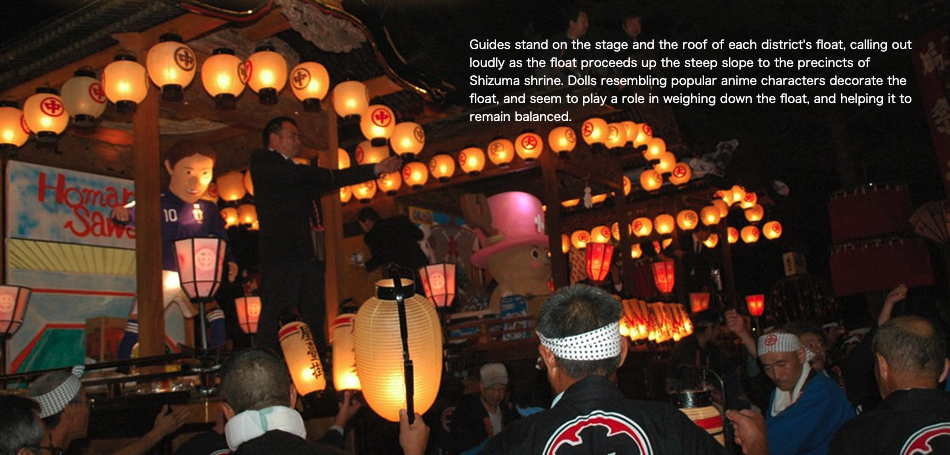
Akitsu district’s Shizuma Shrine stands near the ruins of Shizuma castle, which appeared in classic Japanese tales like the Hogen monogatari and Heike Monogatari. The highlights of the festival are floats from Iiyama’s Kitabata, Nakamachi and Okubo villages. Each year, floats from the three villages are presented as offerings at the hilltop Shinzuma Shrine. Built between late Edo period and early Meiji era, the floats are decorated with everything from engravings and ceiling murals to depictions of popular anime characters, joining together Japan’s traditional and popular cultures. Children from each village perform with flutes and taiko drums and guides on the roof of the floats call out loudly, creating a lively atmosphere.
The floats parade through each village, scattering candy as they go, before gathering at the shrine entrance around 9pm. One by one, the villagers pull each of the floats up the steep slope to the shrine precincts. To encouraging shouts, everyone raises the thick rope connected to the float and begins to pull it up the steep slope to the shrine. This is the festival’s most spectacular event, and becomes something like a tug of war. The villages sponsoring the float want it to proceed up the hill slowly, while the cooperating villages hope to get the float to the shrine more quickly. This face-off is always interesting to watch.
Watching floats it is obvious that size and form are very different among three villages. A float of Okubo is the biggest and the difference is obvious because of the number of lanterns. This float has the carving of an excellent dragon by sculptor, Shikai Kitamura from Nagano City, on the wooden panel and it is said that he might make the sculpture of the ceiling of the float and the float itself. In contrast, Nakamachi’s is the smallest and judging from the thickness of the rope it is relatively thin. Somehow, as there are not so much inhabitants totally, it is difficult to pull up to the shrine. It is really said that they just put it on the shrine side because it is hard to assemble a float.
By the way, when three floats go up on the precincts the primary school boys of each village performed the dance of the Japanese halberd on the stage assembled only at the time of festival beside a front shrine every year. Clothes and the choreography were also varied according to a village, and a shout and applause were finished from the audience. A lion dance and “Kanda-bayashi” (Kanda musical accompaniment) were dedicated and it understood the tradition inherited for a long time from an adult to a child afterwards. Both an adult and a child, taking a local pride, practice earnestly toward the purpose id to show the best performance in public. It developed a local bond and seemed to give an impression on the audience.
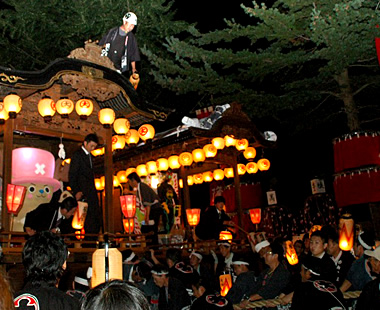
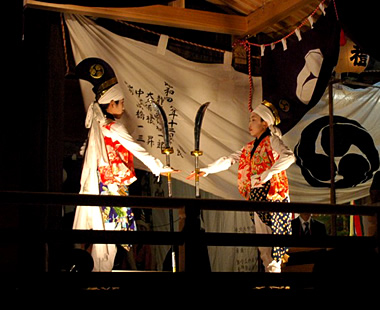
Location: Shizuma Shrine – Iiyama City, Shizuma 1213
Date: Third weekend in September (Saturday/Sunday)
Inquiry: Shinshu-Iiyama Tourism Bureau
TEL: 0269-62-3133
Daitengu(Great long-nosed goblin)of Narazawa Shrine(Narazawa Destrict)
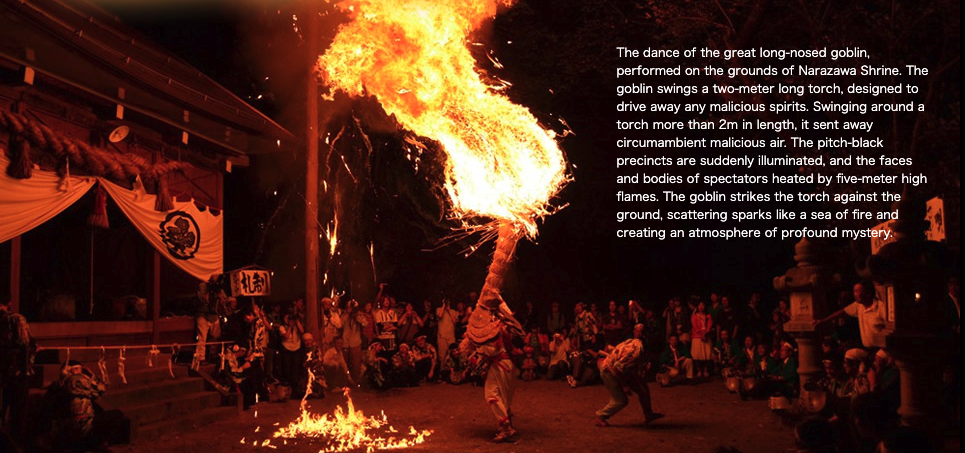
Known for its “dance of the long-nosed goblin,” Narazawa Shrine’s festival traditions have been preserved through relics from Japan’s hunting age. Of all the fall festivals in Iiyama, the Narazawa Shrine festival is particularly intense, drawing crowds of amateur photographers every year. During the festival, sarutahiko (the great long-nosed goblin) prays for peace among the villagers, dances with a katana and a large torch, and uses the katana to cut ceremonial ropes strung along the shrine boundaries and shrine office before proceeding to the shrine. Other traditional dances offered at the shrine include the Japanese halberd dance, small long-nosed goblin dance, Onbe (Shinto staff with paper streamers) dance, sword dance, Suzu-onbe (onbe with bells) dance, and Mottare dance. When moving from path to path, an original kazoe-uta (counting song) is also sung, bringing forth feelings of nostalgia and longing for home.
In the main section of the great long-nosed goblin dance, Sarutahiko swings a big torch more than two meters in length. It’s an amazing sight. The normally dark area shines in the torchlight, and the heat of the torch raises the temperature enough to make spectators break out in a sweat. Even so, it’s considered lucky to touch sparks from the torch brandished by the long-nosed goblin, so people sit close-by as they watch the dance. The night-illuminating torchlight and the valourous dance create a mystical atmosphere, the flame recalling past ancestors and rekindling a sense of faith. Throngs of spectators, two or three rows deep, shout and clap their hands during the dance of the long-nosed goblin, praying for the village’s safety and tranquility, as well as the harvest of a bumper crop. With a proud history of more than 300 years, the long-nosed goblin dance has been designated one of Iiyama City’s folk custom cultural assets.
After swinging the huge torch, the great long-nosed goblin throws it at a ceremonial Shinto rope stretched across the shrine office five meters ahead. When the torch is thrown, drawing an arc through the air, one of the shrine parishioners waiting near the rope makes a spectacular catch, and is rewarded with applause. The festival draws not only elementary and middle school students, but high school and university students, as well as many people in their 20s. Many young people call out, giving voice to the support that unites locals and fills participants with a sense of happiness and pride.
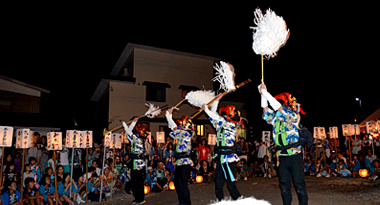
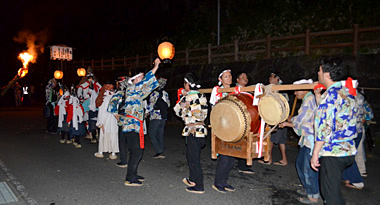
Location: Narazawa Shrine – Iiyama City, Iiyama 8975
Date: Third weekend in September (Sat/Sun)
Inquiry: Shinshu-Iiyama Tourism Bureau
TEL: 0269-62-3133
Gosoku-daidaikagura(sacred music and dance)(Toyota District)
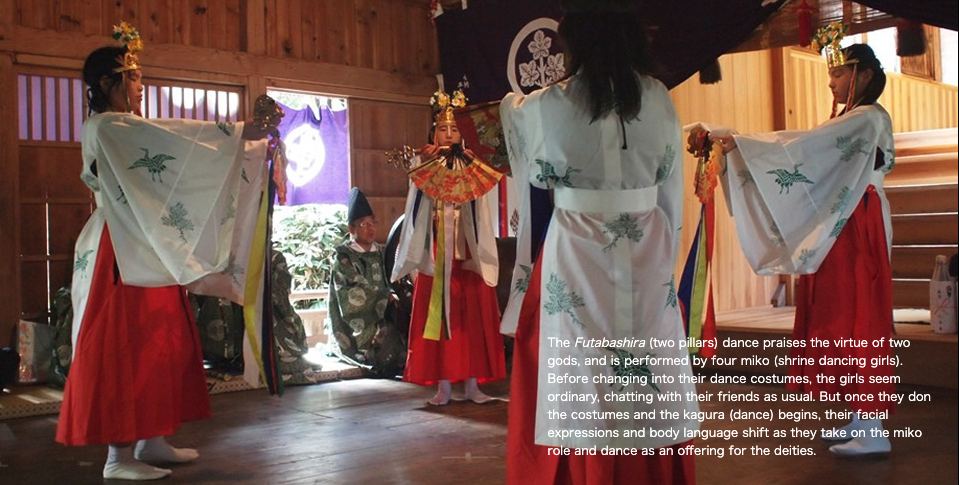
The Gosukudaidai-kagura is held twice a year, once each in spring and fall. This traditional song and dance is held at Takeminakata-tominomikoto-hikokamiwake-no-jinja (shrine) in Iiyama’s Togari village, and has been carefully preserved and passed down by a locally organized preservation society.
A trip to the shrine takes approximately 20 minutes by car from the center of Iiyama City. A drive through rural districts of golden fields will bring you to the shrine entrance. Located in the center of the village, the shrine is on the hill, surrounded by beautiful trees and clear springs. This atmosphere will make any visitor feel the sacred nature of the temple.
When the kagura (traditional song and dance) begins, local people gradually make their way to the shrine; a young couple holding a baby, a stooped older woman bowing respectfully, and cheerful children from the neighborhood. It’s lovely to see the festival scenery, rooted in the lives of local people and recreated for more than 300 years.
The performances of the day are Futabashira (two pillars), the Ebisu dance, and the dance of Urayasu. Accompanied by the gentle tone of traditional Japanese instruments, including taiko drums, koto (similar to a harp), ryuteki (flute), and sho (oboe), people dance as an offering to the shrine’s deity. Sometimes the music is solemn, sometimes cheerful. At the small offering stand, with shutters removed on three sides, the Togari wind and the sound of rustling branches mix with prayers directed at the sky. Amidst the nature and landscape shaped by local people, this festival is performed anew each year, as it has been for centuries.

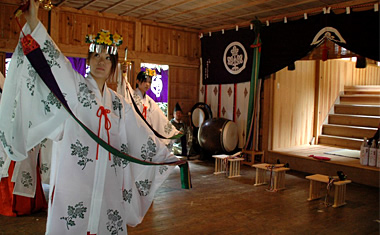
Location : Takeminakata-tominomikoto-hikokami-wakeno Shrine – Iiyama City, Toyota 3681-1
Date: mid-September
Inquiry: Shinshu-Iiyama Tourism Bureau
TEL: 0269-62-3133
Column:
Hashira-matsusaito shinji (Kosuge Shrine annual festival)
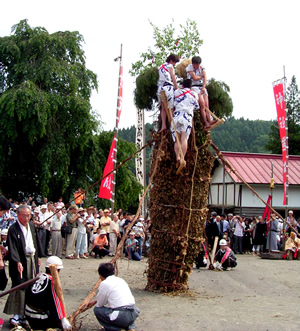
This religious festival is held once every three years as part of the Kosuge Gion Festival. It is hosted by Kosuge Shrine, one of the three most sacred places in northern Nagano for mountain ascetics. Held as an event for mountain ascetics since the Nara period (710-794), the event is also commonly called “Matsuko of Kosuge,” and is known throughout Japan for its unusual rituals.
In the open area before the lecture hall, two pine tree pillars are prepared, bundled with various small trees and wrapped in wild grape vines. In keeping with ancient rites, a portable shrine supporting the deity Susano-onomikoto is carried out of the shrine. Then, a child (called matsu-miko) ascends each pillar and uses flint to set fire to the obana (Japanese pampas grass) at the pillar’s top, each attempting to complete the feat fastest.
According to festival tradition, a win by the older child will usher in an time of peace and tranquility. A win by the younger child promises an abundant harvest. This historic festival has been designated both a Prefectural and National Important Intangible Cultural Property. The two children chosen as Matsumiko hike the 1.5 kilometers to the inner Kosuge shrine the night before the festival, and cleanse themselves at the shrine before performing their important role.
Location: Lecture hall yard, Kosuge village shrine – Iiyama City, Mizuho, Kosuge
Date: The weekend closest to July 15 each year
(Hashiramatsu-saito shinji is held once every three years – the next festival is in 2016)
Inquiries: Shinshu-Iiyama Tourism Bureau
TEL: 0269-62-3133



